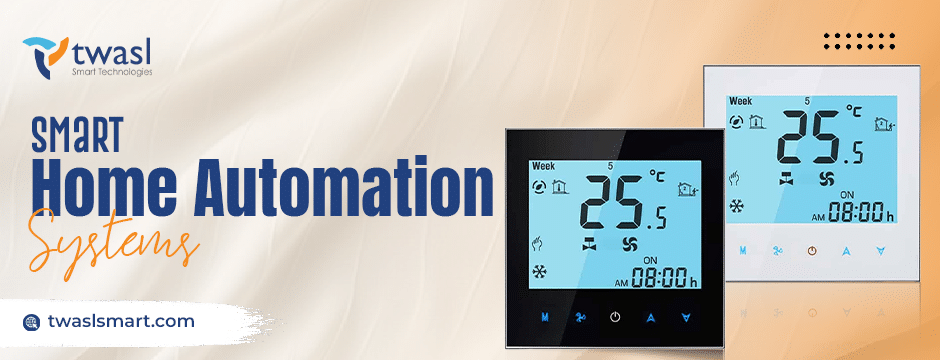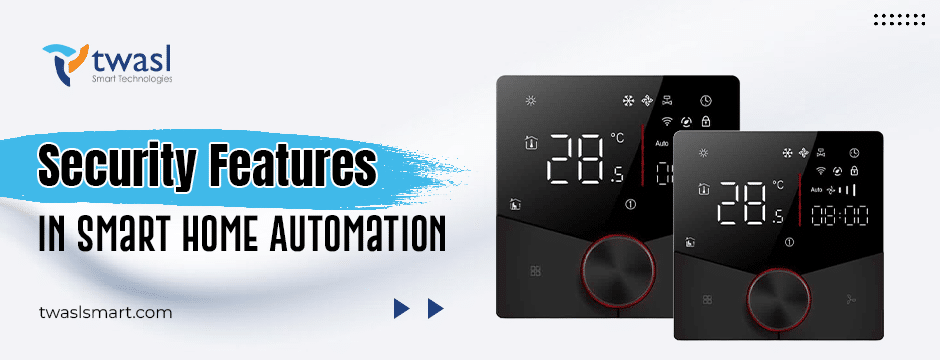Top Security Features to Look for in a Smart Home Automation System

With the Smart Home Automation system, there’s been quite a transformation as far as how we interact with our living spaces. These technologies range from adjusting the thermostat remotely to switching lights and security systems on or off using a normal tap on our smartphone. These advancements bring unmatched convenience and efficiency to our lives. However, with homes becoming smarter, there comes the question of security: The safety of smart homes from hackers raises several questions and what aspects the homeowner must focus on; this has also become critical. This blog will explore the main security features that should be reflected in investing in a smart home automation system.

Introduction to Smart Home Automation Systems
Definition and Components of Smart Home Automation
Smart home automation is the integration of technology into home systems such that people can monitor and control most appliances in the house remotely. Its components include smart lighting, heating and cooling systems, security cameras, and home appliances. The beauty of a smart home lies in its ability to streamline daily tasks, improve energy efficiency, and enhance security.
However, with increased connectivity comes vulnerability, and smart home automation is no exception. Hackers often target smart devices. Security should be the utmost concern when selecting smart products and systems.

The Role of Security Features in Enhancing Home Safety
The security features in smart homes provide the basis of protection for the home. Such features not only give you peace of mind but also protect your property and members of your family from such threats. As more devices continue to interconnect, ensuring each component is secure is important in maintaining the overall integrity of the system.
Key Security Features in Smart Home Automation
1. Remote Monitoring and Control
Possibly, one of the major advantages of smart home automation is its monitoring and controlling capabilities. Using friendly apps, homeowners will be able to monitor their property from all corners of the globe. This can help particularly in real-time surveillance and control over various aspects of your home.
Key points:
App Interfaces: Most smart home systems come with excellent functional apps that enable users to access the appliances from everywhere. One can see the security camera feeds, set up adjustments on thermostats, or even turn off lights remotely.
Alerts and Notifications: The remote access enables homeowners to have alerts on any suspicious activities that need prompt action.
2. Integration with Security Cameras
Security cameras are a must element of any smart home security system because they offer surveillance and allow users to capture valuable video footage, rendering them quite matchless with a stand-alone camera, especially if combined with smart home devices.
Points to Note:
- Live Feed: With the security cameras, homeowners get a chance to view their homes through live feed from the cameras using their smartphones, thus monitoring them in real-time.
- Recorded footage: Many of the smart home systems offer the option of cloud storage of recorded footage, which becomes easy to access in case of a security breach or an event.
3. Smart Door Locks and Access Control
Smart door locks have changed the concept of securing homes since they provide keyless entry and access from a distance. One of the features that the devices offer is the power of homeowners to deny or accept entry through the lock without the need for physical keys. As such, intruders cannot get any easier entry into homes.
Key Points:
- Keyless Entry: People use a keypad or application on their smartphone to get entry with smart locks and hence rule out the probability of losing keys or theft.
- Remote Locking/Unlocking: Doors can be locked or unlocked through remote operation. In this way, doors will not have the chance of unsecured access if one is away in town.
4. Automated alerts and notifications
Automatic alerts help much in home security. The smart home system can alert homeowners to potential threats, and a response is made instantaneously.
Key Takeaways
- Unauthorized Access Alerts: In case someone is trying to get into your house without your permission, the smart lock or security camera can quickly alert you.
- Environmental Alerts: Sensors will alert the homeowner about smoke, carbon monoxide, or water leaks that can instantly do something to mitigate the risks.
5. Environmental Sensors
You can also include environmental sensors in your smart home setup in order to heighten its security. These are units that can detect potential threats that may compromise the safety of your family and your house.
Key Takeaways:
- Smoke and Carbon Dioxide Detectors: Smart smoke detectors will send alerts to your phone if they detect smoke or carbon monoxide.
- Water Leak Sensors: Sensors may possibly detect leaks even before your house has massive water damage, plus mold buildup.
6. Encryption and Data Privacy Features
Smart home devices collect data and transmit it to the respective services, making their data privacy more essential and valuable. Therefore, data encryption is the one thing that people must go through as a step to secure personal information against cyber attacks.
Key Takeaways:
- Encryption Standards: Find smart home systems employing strong encryption standards to protect data transmission.
- Privacy policies: The manufacturer should explicitly state privacy policies. They must respect user privacy and have guidelines on how they’re going to use and store data.
7. Home Security System Compatibility
Your smart home automation system can be integrated into other home security systems to give you a complete and strong security network. Compatibility integrates multiple devices, through which maximum protection will be achieved.
- Single Control Interface: A single control interface for all the devices makes management easier and offers a great experience for users.
- Advanced Security Features: Integration of smart devices with traditional security can offer layer protection, which will be hard to do for intruders to pass through the security.

Smart Home Automation Product with Advanced Security
1. Smart Switch
A smart switch will allow the homeowner to control lights from anywhere. This goes beyond just convenience in using the feature—it also serves as a possible deterrent to intruders.
Security Functionality:
- Remote Control: Homeowners have the ability to remotely turn lights on and off, which simulates someone being home even if they are away.
- Scheduling: To provide the appearance of a lived-in home, users can program lights to turn on and off at predetermined intervals.
2. Smart Thermostat
While these products are mostly intended for energy efficiency, they can also contribute to the safety of the home.
Security Feature:
- Away Modes: Nearly all smart thermostats carry an “away” mode that allows letting the thermostat out when you’re away from home, so it is less likely that an intruder will suspect that a house is empty.
- Security Systems: Smart thermostats can also be programmed to alert the homeowner if there are abnormal temperature changes, such as from a fire.
3. Smart socket
Smart plugs offer remote control of appliances, aiding in security by preventing potential theft.
Security Functionality:
- Remote Power Control: The smart sockets allow the owner to turn on and off appliances from a remote distance, hence discouraging intruders who may identify appliances as left on.
- Automated Scheduling: Smart sockets enable programming of appliances so that appliances change devices at specific times, thus ensuring improved security.
4. Smart Neon Light Strip
These strips offer ambiance in homes but can be used to improve security.
Security Functionality:
- Visibility: Vibrant, colorful lights can improve the visibility surrounding your property and deter potential burglars.
- Smart Home Security: You can even control your lights remotely and make it seem like someone is occupying the place.

Additional Considerations in Smart Home Security
As important as the features above are to your smart home security, below are even more things to think about when reviewing your smart security:
1. Automatic software upgrades and gadgets
Smart devices must receive regular software updates for security purposes. Manufacturers provide updates with new features and functionalities to enhance the devices’ work processes.
Key Takeaways:
- Automatic Upgrades: Whenever possible, enable automatic updates to keep devices running with the latest software.
- Device Management: In most cases, inspect devices periodically for issues or malfunctions that would lead to a security breach.
2. Multi-factor authentication
Multi-factor authentication brings another layer to the smart home system in terms of security. In this case, a verification of two or more different methods is required before gaining access to users’ devices.
Key Points:
- Verification Methods: Among the common verification methods that can be used are typing a password, fingerprinting, or one-time codes, which are to be sent via a registered phone number.
- Enhanced Security: Multi-factor authentication is also much more secure compared to single-factor authentication. It reduces the risk of unauthorized access substantially and will harden it to hackers breaking into your smart home system.
3. Professional Installation and Support
Though there are countless smart home devices that are self-installable, professional installation will ensure the safety and accuracy of the system.
Important Points:
- Professional Service: Experts know how to install appliances safely and get them working effectively with each other.
- Ongoing Support: Select companies that can provide on-going support and maintenance for possible security threats.
How Secure Are Smart Homes from Hackers?
How safe are smart homes from hackers? Smart homes have been one of the biggest concerns, considering the evolving nature of cyber threats. Here are some points to ponder on:
1. Vulnerability in Smart Devices
Most smart devices remain without security measures or default passwords, which makes them vulnerable to hacking attacks. First and foremost, default settings and passwords should be changed once the device is installed.
2. Secure Your Wi-Fi Network
For example, an encrypted home Wi-Fi network is a typical first deflection point for any hacker. Ensure that your Wi-Fi has a very strong password and you are using a different network for those smart devices.
3. Security Audits
Another measure is to perform regular security audits on smart home devices. You need to ensure whether there are any updates for software, update their settings, and make sure no unauthorized appliances have access to your network.
4. Brand reputation counts
Product deployment from brands that are quite known lowers the risk of hacking attacks. Ensure the brand is aware of security, offers encryption at a good level, and has a transparent privacy policy.
Conclusion
With advancements in smart home technology, security features have become an essential requirement for any homeowner. Knowing what a secure smart home automation system entails enables one to make the right decisions to ensure that their property and loved ones are well protected. Features such as remote monitoring or data encryption become the determining factors for building a safe and efficient living environment.
This is not only a tool for convenience but also for safety; it saves your home from possible threats. Choosing products with strong security capabilities, keeping a secure network, and staying up-to-date on the best practices are considered prudent measures in the safe enjoyment of a smart home.
Wish to get the best smart home products? Visit us at Twasl Smart Technologies.
